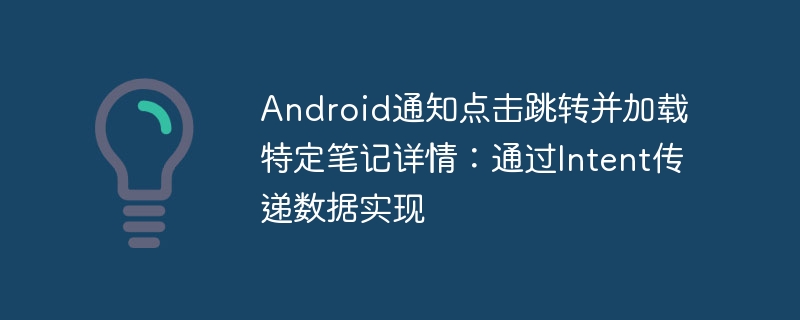Android通知跳转笔记详情:Intent传参技巧
时间:2025-08-06 22:03:42 331浏览 收藏
小伙伴们有没有觉得学习文章很有意思?有意思就对了!今天就给大家带来《Android点击通知跳转笔记详情:Intent传参实现方法》,以下内容将会涉及到,若是在学习中对其中部分知识点有疑问,或许看了本文就能帮到你!

在Android应用开发中,为用户提供提醒功能是常见的需求,例如为待办事项或笔记设置提醒。当提醒触发并显示通知时,用户通常期望点击通知后能够直接跳转到与该提醒关联的具体内容页面,例如特定的笔记详情页。本教程将详细介绍如何实现这一功能,确保点击通知后能够准确无误地打开并显示对应的笔记内容。
问题分析:为何不应依赖列表位置?
在处理列表数据时,开发者可能会自然想到使用列表项的position来标识数据。然而,对于需要通过通知或后台服务访问的特定数据,直接依赖RecyclerView中的position是不可靠的。这是因为列表的position是动态变化的:当用户添加、删除或重新排序笔记时,原有笔记的position可能会发生改变。因此,我们需要一个稳定且唯一的标识符来定位笔记,通常这个标识符就是笔记在数据库中的唯一ID。
解决方案核心:通过Intent传递唯一ID
解决此问题的关键在于利用Android的Intent机制,在整个流程中传递笔记的唯一标识符(例如数据库ID)。具体流程如下:
- 在设置闹钟时,将笔记的唯一ID作为Intent的额外数据(extras)传递给AlarmReceiver。
- AlarmReceiver接收到闹钟触发的Intent后,从中取出笔记ID,并将其重新放入启动目标Activity(如NoteDetail)的Intent中。
- 目标Activity启动后,从其接收的Intent中获取笔记ID,并使用此ID从数据源(如数据库)中查询并加载完整的笔记详情。
实现步骤
1. 设置闹钟时携带笔记ID
在设置闹钟(setAlarm方法)时,我们需要将与闹钟关联的笔记的唯一ID(以及其他必要信息,如标题)放入启动AlarmReceiver的Intent中。
import android.app.AlarmManager;
import android.app.PendingIntent;
import android.content.Context;
import android.content.Intent;
import android.os.Build;
import android.widget.Toast;
import java.util.Calendar;
// 假设此方法在某个Activity或Service中调用
private void setAlarm() {
Calendar calendar = Calendar.getInstance();
// 设置小时和分钟,使用HOUR_OF_DAY避免AM/PM问题
calendar.set(Calendar.HOUR_OF_DAY, hour);
calendar.set(Calendar.MINUTE, minute);
calendar.set(Calendar.SECOND, 0); // 将秒设为0,确保精确到分钟
alarmManager = (AlarmManager) getSystemService(Context.ALARM_SERVICE);
Intent intent = new Intent(this, AlarmReceiver.class);
// 关键步骤:将笔记的唯一ID和标题放入Intent的extras中
// 假设您有一个方法可以获取当前笔记的ID和标题,例如从一个Note对象中获取
// String currentNoteId = myNoteObject.getId();
// String currentNoteTitle = myNoteObject.getTitle();
// intent.putExtra("id", currentNoteId);
// intent.putExtra("title", currentNoteTitle);
// 这里使用示例数据,实际应用中请替换为真实的笔记ID和标题
intent.putExtra("id", "unique_note_id_123");
intent.putExtra("title", "我的提醒笔记标题");
// PendingIntent.FLAG_UPDATE_CURRENT 确保如果PendingIntent已存在,则更新其extras
// 对于API 31 (Android 12) 及更高版本,为了安全性,推荐使用 PendingIntent.FLAG_IMMUTABLE 或 FLAG_MUTABLE
int pendingIntentFlags;
if (Build.VERSION.SDK_INT >= Build.VERSION_CODES.M) {
pendingIntentFlags = PendingIntent.FLAG_UPDATE_CURRENT | PendingIntent.FLAG_IMMUTABLE;
} else {
pendingIntentFlags = PendingIntent.FLAG_UPDATE_CURRENT;
}
pendingIntent = PendingIntent.getBroadcast(this, 0, intent, pendingIntentFlags);
// 设置精确闹钟 (AlarmManager.RTC_WAKEUP 会在设备休眠时唤醒设备)
alarmManager.setExact(AlarmManager.RTC_WAKEUP, calendar.getTimeInMillis(), pendingIntent);
Toast.makeText(this, "闹钟已设置", Toast.LENGTH_SHORT).show();
}注意事项:
- "id"和"title"是您自定义的键名,用于在Intent中传递数据。请确保这些键名在发送和接收端保持一致。
- "unique_note_id_123"和"我的提醒笔记标题"应替换为实际的笔记数据。通常,id会是数据库中的主键或其他唯一标识符。
- PendingIntent.FLAG_UPDATE_CURRENT标志允许在PendingIntent已存在时更新其附加数据。在Android 12 (API 31) 及更高版本中,为了安全性,建议同时使用FLAG_IMMUTABLE(如果PendingIntent内容不需要修改)或FLAG_MUTABLE(如果需要修改)。
2. 在BroadcastReceiver中转发数据
当闹钟触发时,AlarmReceiver的onReceive方法会被调用。此时,我们需要从接收到的Intent中取出笔记ID和标题,并将它们重新放入用于启动目标Activity(如NoteDetail)的Intent中。
import android.content.BroadcastReceiver;
import android.content.Context;
import android.content.Intent;
import android.app.PendingIntent;
import android.os.Build;
import androidx.core.app.NotificationCompat;
import androidx.core.app.NotificationManagerCompat;
public class AlarmReceiver extends BroadcastReceiver {
@Override
public void onReceive(Context context, Intent intent) {
// 从触发AlarmReceiver的Intent中获取笔记ID和标题
String noteId = intent.getStringExtra("id");
String noteTitle = intent.getStringExtra("title");
// 创建用于启动目标Activity的Intent
// 假设 NoteDetail.class 是您的笔记详情Activity
Intent targetIntent = new Intent(context, NoteDetail.class);
// 设置Intent标志,确保Activity以正确的方式启动
targetIntent.setFlags(Intent.FLAG_ACTIVITY_NEW_TASK | Intent.FLAG_ACTIVITY_CLEAR_TOP);
// 关键步骤:将获取到的笔记ID和标题放入目标Activity的Intent中
targetIntent.putExtra("id", noteId);
targetIntent.putExtra("title", noteTitle); // 如果需要,也可以传递标题
// 创建PendingIntent以在通知点击时启动目标Activity
// 同样,考虑API 31+的FLAG_IMMUTABLE 或 FLAG_MUTABLE
int pendingIntentFlags;
if (Build.VERSION.SDK_INT >= Build.VERSION_CODES.M) {
pendingIntentFlags = PendingIntent.FLAG_UPDATE_CURRENT | PendingIntent.FLAG_IMMUTABLE;
} else {
pendingIntentFlags = PendingIntent.FLAG_UPDATE_CURRENT;
}
PendingIntent pendingIntent = PendingIntent.getActivity(context, 0, targetIntent, pendingIntentFlags);
// 构建并显示通知
NotificationCompat.Builder builder = new NotificationCompat.Builder(context, "alarmChannel")
.setContentTitle(noteTitle != null ? noteTitle : "提醒") // 使用传递的标题或默认标题
.setContentText("点击查看笔记详情") // 通知内容
.setAutoCancel(true) // 用户点击后自动取消通知
.setDefaults(NotificationCompat.DEFAULT_ALL) // 使用默认铃声、震动、LED灯
.setSmallIcon(R.drawable.alarm) // 小图标,请替换为您的图标资源
.setPriority(NotificationCompat.PRIORITY_HIGH) // 高优先级
.setContentIntent(pendingIntent); // 设置通知点击行为
NotificationManagerCompat managerCompat = NotificationManagerCompat.from(context);
// 通知ID (123) 应该根据具体情况进行管理,以确保唯一性,或者根据需要更新现有通知
managerCompat.notify(123, builder.build());
}
}注意事项:
- NoteDetail.class应替换为您实际用于显示笔记详情的Activity类。
- Intent.FLAG_ACTIVITY_NEW_TASK:确保Activity在一个新的任务栈中启动,这对于从非Activity上下文(如BroadcastReceiver)启动Activity是必需的。
- Intent.FLAG_ACTIVITY_CLEAR_TOP:如果目标Activity已经在任务栈中存在,则将其上方的所有Activity清除,并将目标Activity带到栈顶。这有助于避免创建多个相同的Activity实例。
- 通知ID(123)用于标识通知,如果您需要更新或取消特定通知,可以使用此ID。对于不同的通知提醒,建议使用不同的ID,例如可以使用笔记ID作为通知ID的一部分。
3. 在目标Activity中加载笔记
本篇关于《Android通知跳转笔记详情:Intent传参技巧》的介绍就到此结束啦,但是学无止境,想要了解学习更多关于文章的相关知识,请关注golang学习网公众号!
-
501 收藏
-
501 收藏
-
501 收藏
-
501 收藏
-
501 收藏
-
362 收藏
-
281 收藏
-
229 收藏
-
166 收藏
-
287 收藏
-
136 收藏
-
308 收藏
-
249 收藏
-
495 收藏
-
175 收藏
-
466 收藏
-
272 收藏
-

- 前端进阶之JavaScript设计模式
- 设计模式是开发人员在软件开发过程中面临一般问题时的解决方案,代表了最佳的实践。本课程的主打内容包括JS常见设计模式以及具体应用场景,打造一站式知识长龙服务,适合有JS基础的同学学习。
- 立即学习 543次学习
-

- GO语言核心编程课程
- 本课程采用真实案例,全面具体可落地,从理论到实践,一步一步将GO核心编程技术、编程思想、底层实现融会贯通,使学习者贴近时代脉搏,做IT互联网时代的弄潮儿。
- 立即学习 516次学习
-

- 简单聊聊mysql8与网络通信
- 如有问题加微信:Le-studyg;在课程中,我们将首先介绍MySQL8的新特性,包括性能优化、安全增强、新数据类型等,帮助学生快速熟悉MySQL8的最新功能。接着,我们将深入解析MySQL的网络通信机制,包括协议、连接管理、数据传输等,让
- 立即学习 500次学习
-

- JavaScript正则表达式基础与实战
- 在任何一门编程语言中,正则表达式,都是一项重要的知识,它提供了高效的字符串匹配与捕获机制,可以极大的简化程序设计。
- 立即学习 487次学习
-

- 从零制作响应式网站—Grid布局
- 本系列教程将展示从零制作一个假想的网络科技公司官网,分为导航,轮播,关于我们,成功案例,服务流程,团队介绍,数据部分,公司动态,底部信息等内容区块。网站整体采用CSSGrid布局,支持响应式,有流畅过渡和展现动画。
- 立即学习 485次学习
